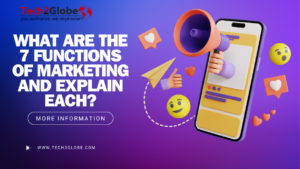Summary: We will break down each of the five Ps in this guide using real-world examples to enable you to understand their application. Also, explore their importance and how to use them effectively.
Key Takeaways:
- Promotion is a strategy through which customers learn about your product or service. Some say this is the most important of the 5 Ps.
- The price you set for your product is essential to balance what customers are willing to pay.
- Also, products or services are the foundation of your marketing plan.
- Remember that how you reach your market and grow revenue depends on Distribution channels.
Considering marketing, the five Ps offer a solid basis for creating plans that can enable a company to flourish in today’s competitive climate. Like most of us, if you own a business, you want to know how to present your goods, draw in business, and create unique brand recognition. In this case, the 5Ps of marketing come into play: Product, Price, Place, Promotion, and People. Knowing each of these components helps companies concentrate and align with their marketing objectives.
What are the 5 P’s of Marketing?
The 5 ps of marketing are critical to an effective marketing mix plan. This mix refers to brands’ activities to sell their products and services, which are organized around five basic components: product, place, pricing, promotion, and people.
The 5Ps were first used in the late 1940s but were only a 4-part model: price, product, place, and promotion. Afterward, “people” were added. Most agree Kotler is the “father of modern marketing.” He is also well-known for standardizing the definition of the marketing mix.
1. Product: What are you selling?
The first P is the most important—your product. This speaks to the items or services your business provides. It covers the actual goods and its design, features, and packaging. This is where your value proposition—that exceptional edge your product offers over others on the market—fits.
For instance, consider Apple and its iPhone. The iPhone is a status symbol, a handy tool with a flawless interface with other Apple products, and not just a phone. Apple stresses the gadget and its ecosystem, therefore acquiring a competitive advantage in the smartphone industry.
2. Price: What’s It Worth?
Price comes next; this is the price consumers would be ready to pay for your item. Pricing policies could change based on the state of the market, level of competition, and apparent worth of your item. Attracting your target market depends on deciding whether to price low to compete on cost or high for a luxury appeal. Getting the pricing right is, therefore, vital.
For instance, Starbucks has become very skilled in premium pricing. Though Starbucks’ coffee cup costs more than a regular café, customers are ready to pay for the brand, the experience, and the supposed quality. Starbucks can charge a premium without losing consumers by concentrating on branding and customer experience.
3. Place: From where are you selling it?
Place describes the distribution of your goods, both geographically and elsewhere. It’s all about getting your goods in front of the proper audience at the appropriate moment. Whether your company runs a physical store, online, or both, your success depends on knowing where your clients will likely purchase.
For instance, Amazon exemplifies excellent location optimization. Since they are practically totally online, consumers can easily buy from anywhere globally. They provide convenience, but their sophisticated logistics system guarantees that items get to consumers rapidly. Many companies find that selecting the correct sales platform makes or breaks their marketing campaigns.
4. Promotion: How Are You Getting the Word Out?
Promotion encompasses all the means of contact you use with your target market. This might call for PR initiatives, social media, advertising, etc. Moreover, the objective is to increase knowledge of your product and inspire its purchase. As a result, your promotion approach should be catered to your target and the message you wish to transmit.
For instance, Coca-Cola is a well-known firm for its outstanding marketing plans. Coca-Cola is adept at getting its message in front of its consumers, whether it means through its worldwide holiday marketing or engaging social media content. Their marketing frequently arouses feelings and reminiscence, which helps the brand to be more approachable and exciting.
5. People: Who’s Involved in the Process?
The last P, People, speaks about your clients and the personnel behind your offering. Having the correct personnel guarantees that every customer touchpoint—marketing to customer service—delivers a consistent and favorable experience. Driving commercial success is primarily dependent on your staff and partners.
For instance, Zappos, an online shoe retailer, has built its brand around exceptional customer service. Their customer-centric attitude distinguishes them from their rivals. Employees at Zappos are taught to surpass expectations so that every time they connect with the business, consumers enjoy buying.
Importance of 5 P’s of marketing
The biggest advantage the five Ps of marketing provide is improved capacity for focusing on your primary marketing goals. They do this by laying a structure that directs all of your projects and promotes harmony. Once you have set your basic pillars, it is far easier to find the areas of your company that call for further help.
If you find it difficult to sell, you can decide to study your ability to reach your target market or the product costs. For you, the five Ps of marketing make all the business functions easier.
Example of the 5 P’s of Marketing
Sarah wants to open a kayak rental shop for tourists who love outdoor adventures. Here’s how she can use the 5 Ps to set up her business:
Product: She will offer hourly kayak rentals for visitors. Customers will sign a waiver, and a security deposit will be required in case of any damage to the kayaks.
Price: Sarah will keep her prices low to attract budget-friendly tourists. She can also give a 10% discount to groups that book through local hotels.
Promotions: She will create social media accounts on Facebook and Instagram to promote her business. Sarah can also advertise on travel websites and blogs to reach more potential customers.
Place: The kayak rental shop will be located near popular tourist spots and public transportation for easy access.
People: Sarah will hire friendly staff who enjoy meeting travelers and providing excellent customer service.
How To Use the 5 P’s Effectively?
1. The product must meet the needs of the Market.
Making sure that your product meets actual client demands is critical to success. Thus, do your homework by conducting market research, customer interviews, behavioral data analysis, and buyer persona creation. Also, dig deep to understand your audience’s goals, pain spots, and preferences and include them in the final product.
A deep understanding of your product’s value proposition is essential for marketers. You must clearly explain how features and capabilities solve consumers’ problems. Additionally, product expertise helps SaaS marketers create engaging messaging and differentiated growth plans.
2. Be strategic; set competitive, fair pricing.
Pricing is integral to marketing because it affects demand and how people think about a product. To set prices correctly, you need to consider operational costs, market conditions, customer behavior, and how your company will be perceived. For some businesses, giving unique products at a higher price works well, while cost-plus or subscription plans work better for others. Competitive research helps you stay strong in the market. Additionally, consider using strategies like bundles, subscriptions, and dynamic prices to get the most value.
3. Expand strategically; reach broader market audiences.
You need to use strategic distribution through the right platforms to reach and engage your audience. First, plan to roll out in key places, then move on to new areas. Language and cultural differences can significantly affect how a product is advertised and how much it costs. Study the market extensively to learn about the differences between regions and adjust your ads as needed.
Moreover, join forces with media, channels, and leaders influential to your area. Event marketing, both in person and online, also provides valuable chances to interact with people in real life and make digital contacts that can be scaled up through workshops.
4. Choose targeted channels for effective promotion.
As a marketer, an integrated promotional strategy drives audience awareness and nurtures relationships, keeping your funnel performing.
Optimize your promotion efforts across channels by:
- Paid Media: Use targeted ads for top-of-funnel demand, measuring ROI regularly.
- Content Marketing: Create blogs, videos, e-books, and more to engage and establish authority.
- Earned Media/PR: Invest in PR for reviews and media mentions to build credibility.
- Email Marketing: Use automated drip sequences to nurture leads.
- Social Media: Distribute content and engage audiences organically.
- Event Marketing: Host in-person and virtual events, driving engagement with automation tools.
5. Know your audience; engage them meaningfully.
People include your internal teams implementing plans and your exterior audiences. Along with good recruiting practices, you and your marketing staff need chances to upskill and use the correct engagement marketing technologies.
Most significantly, great marketers care about their audience. Therefore, approach your ideal client by considering:
- Demographics
- Psychographics
- Habits
- Needs, wants, and goals
- Challenges and pain spots
- Content tastes
- Buying process
Sample Marketing Plan Template
While creating a marketing plan from the start might take time, company success depends on having one. By giving you a clear framework to establish your objectives, target audience, and methods, a sample marketing plan template will help you to streamline the process.
Usually including information on market analysis, budget allocation, and key performance indicators (KPIs) help you monitor progress. Also, you may search for free plan templates online.
Conclusion
Fundamentally, Product, Price, Place, Promotion, and People—the five Ps of marketing—guide companies toward successful plans. Perfecting every component helps businesses satisfy consumer expectations and gain a competitive advantage in the market. Maintaining the five Ps in mind can help your company remain on target and flourish, whether adjusting your pricing model, honing your product offering, or strengthening your marketing plan.
We provide various marketing options through our SMO services to propel your company forward if you need professional assistance implementing these ideas.

Sarabjeet Singh is the Vice President of Operations at Tech2Globe and brings over 15 years of experience in various industries, including IoT, education, retail, government, FMCG, hospitality, and e-commerce. His leadership focuses on operational excellence and exceeding customer expectations, implementing contemporary solutions. Sarabjeet’s expertise spans e-commerce consulting, software development, data management, BPO/KPO support services, digital marketing, graphics, and startup consulting. He fosters a collaborative work environment, ensuring Tech2Globe delivers high-quality solutions.










